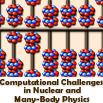Speaker
Prof.
Doru S. Delion
(Horia Hulubei National Institute of Physics and Nuclear Engineering, POB MG-6, Bucharest, Romania)
Description
Nuclear structure is better understood in terms of interacting building blocks.
As the first example we discuss the coupled channel Quasiparticle Random Phase
Approximation (ccQRPA) for even-even deformed nuclei [1]. The basic building blocks
are particle states coupled with the Wigner function to a given total spin.
In this way, we are able to describe collective excitations in deformed nuclei
by using building blocks with good angular momentum in the laboratory system.
We obtain a system of coupled QRPA equations with different multipolarities.
An application to E2 transitions shows a significant improvement for the well
deformed region in comparison to the standard QRPA. Several applications are proposed.
As a second example we describe electromagnetic and alpha transitions in even-even
nuclei by using a common approach for spherical, transitional and deformed nuclei [2].
We use projected coherent states to describe the structure of daugher nuclei and a
quadrupole-quadrupole alpha-core interaction to compute decay widths to excited states.
It turns out that the strength of this interaction, reproducing alpha trasitions to
$2^+$ states, is proportional to the clustering probability. Predictions for
electromagnetic
and alpha transitions to excited state are made for all available even-even emitters.
The coupled channel analysis for unfavored alpha transitions in odd mass nuclei
is proposed as a promising tool to investigate nuclear structure by the using
both spectroscopic and alpha decay data.
[1] D.S. Delion, J. Suhonen, Physical Review C87, 024309 (2013).
[2] D.S. Delion, A. Dumitrescu, Physical Review C87, 044314 (2013).
Author
Prof.
Doru S. Delion
(Horia Hulubei National Institute of Physics and Nuclear Engineering, POB MG-6, Bucharest, Romania)
Co-authors
Mr
Alexandru Dumitrescu
(Horia Hulubei National Institute of Physics and Nuclear Engineering, POB MG-6, Bucharest, Romania)
Prof.
Jouni Suhonen
(Department of Physics, University of Jyvaskyla , POB 35, FIN-40351, Jyvaskyla , Finland)

